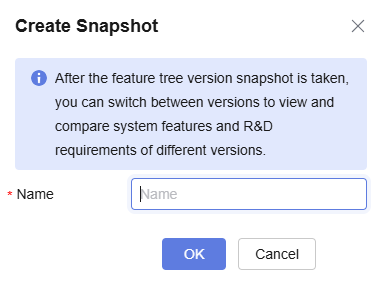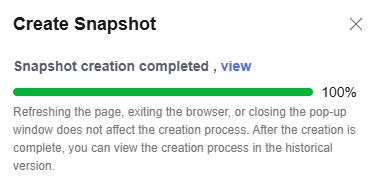After creating a feature tree (see Creating a Feature Tree), you can perform the operations described in this section on it.
Prerequisites
You have created a feature set in an IPD-standalone software project, and have feature set permissions for the project.
Procedure
On the project homepage, choose , and perform the following operations.
Table 1 Managing a feature tree
|
Operation |
Procedure |
|
Search for feature set |
- On the project homepage, choose Feature Tree.
- Enter a keyword in the search box to search for the target feature set.
|
|
Associate system feature with feature set |
You can create system features or associate existing ones with a feature tree. System features of the same type can be put in the same feature set for easy management.
- Creating a system feature
- Click the name of the feature set to associate a system feature.
- Click SF.
- Enter system feature information. For details, see Procedure.
- Click OK. The new system feature is displayed under the corresponding feature set.
|
|
Create feature tree baseline snapshot |
You can create a baseline based on the current feature tree version.
- On the project homepage, choose Feature Tree.
- Click
 . The Feature Tree Version Snapshot dialog box is displayed. . The Feature Tree Version Snapshot dialog box is displayed.
Figure 1 Creating a feature tree snapshot

- Enter a snapshot name.
- Click OK.

The creation process will not be interrupted by refreshing the page, closing the browser, or closing the dialog box. To view the created version, click History Version.
|
|
Compare feature tree version snapshots |
You can compare feature tree snapshots of different versions.
- On the project homepage, choose Feature Tree.
- Click
 and select Compare Snapshots. The snapshot comparison page is displayed. and select Compare Snapshots. The snapshot comparison page is displayed.
- Select the baseline snapshot version to be compared.
- Click the name of the system feature to be compared. The work item version comparison page is displayed.
If a system feature is snapshotted for multiple times on the feature tree page, multiple versions will be generated. You can select and compare different versions.
To compare system feature versions, check historical versions on the Feature Tree page.
1. On the project homepage, choose Feature Tree.
2. Click the SF name to be compared. On the details page, click  on the right and select History Version. On the displayed page, select the snapshot version to be compared and click the version comparison icon. The work item version comparison page is displayed. on the right and select History Version. On the displayed page, select the snapshot version to be compared and click the version comparison icon. The work item version comparison page is displayed.
|
|
Import feature tree |
Use the provided template to import a feature tree.
- On the project homepage, choose Feature Tree.
- Click Import under
 on the right of the page. on the right of the page.
- In the displayed dialog box, click Download Template.
- Set the fields in the template. For details, see the import description in the template file.
- Select the file to be imported.
- Click Import and complete the import as prompted.
|
|
Export feature tree |
Export a feature tree with desired fields to an Excel file.
- On the project homepage, choose Feature Tree.
- Click
 on the right of History Version, and select Export. on the right of History Version, and select Export.
- In the displayed dialog box, select fields to be exported.
- Click Export.
After the feature tree is exported, the file will be automatically downloaded to the local PC. The file format is .xlsx.
|













